|
|
 |
Fiche d'espèce de Copépode |
|
|
Calanoida ( Ordre ) |
|
|
|
Bathypontioidea ( Superfamille ) |
|
|
|
Bathypontiidae ( Famille ) |
|
|
|
Temorites ( Genre ) |
|
|
| |
Temorites sarsi (Grice & Hülsemann, 1965) (F,M) | |
| | | | | | | Syn.: | Bathypontia minor Sars, 1907 a (p.27) (nom. praeoc.); 1925 (p.360, figs.F,M); C.B. Wilson, 1950 (p.171, fig.F); Owre & Foyo, 1967 (p.100, figs.F,M) ;
no Bathypontia sarsi: Wheeler, 1970 (p.12);
Bathypontia sarsi Grice & Hülsemann, 1965 (p.249, Rem.); 1967 (p.19); Roe, 1975 (p.361, figs.F,M, Rem.); Deevey, 1979 (p.737, figs.F,M); Vives, 1982 (p.295) | | | | Ref.: | | | Bradford-Grieve, 1999 b (p.21); Vives & Shmeleva, 2007 (p.399, figs.F,M, Rem.) | 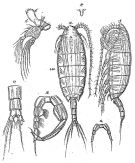 Issued from : G.O. Sars in Résult. Camp. Scient. Prince Albert I, 69, pls.1-127 (1924). [Pl.CXXVII, figs.12-18]. As Bathypontia minor. Female: 12, habitus (dorsal); 13, idem (lateral left side); 14, rostrum; 15, Md; 16, P5; 17, distal part of urosome and caudal rami (dorsal). Male: 18, P5.
|
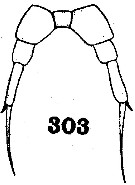 issued from : C.B. Wilson in U.S. National Museum. Bull.100, 14 (4), 1950. [Pl.22, Fig.303]. As Bathypontia minor. Female (from Philippines, S China Sea): 303, P5. Nota: P5 resemble almost exactly like those of Paracalanus parvus.
|
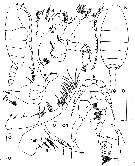 issued from : G.B. Deevey in Proc. Biol. Soc. Wash., 1979, 92 (4). [p.738, Fig.8]. As Bathypontia sarsi. Female (from 17°18'N, 85°27'W): b, habitus (dorsal); c, A2 (setae cut off); d, Mx1 (setae cut off); e, Md; f, Mxp; g, basal segments of Mx2; h, P5; k, Md (masticatory edge). Nota: P5 symmetrical, with apical spine plus small accessory spine. Last thoracic segment pointed in dorsal and lateral view. Male (from 20°02'N, 82°48'W): a, habitus (lateral); i, P5. Sars (fig.18) figures a longer distal spine on the left P5 than is present here.
|
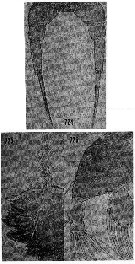 issued from : H.B. Owre & M. Foyo in Copepods of the Florida Current. Fauna Caribaea, 1967, 1, Crustacea, Part 1: Copepoda. [p.100, Figs.724-726]. Female: 724, P5; 725, Md (masticatory edge); 726, Md (mandibular palp).
|
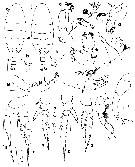 issued from : H.S.J. Roe in Bull. British Mus. (Natural History) Zool., London, 1975, 28 (7). [p.362, Fig.30]. As Bathypontia sarsi. Female (Cape Verde Islands): a, habitus (dorsal); b, last thoracic segment (right lateral side); c, A2; d, Mx2 (left); g, Mxp; h, P5; i, P5 (other specimen). Male: j, habitus (dorsal); k, last thoracic segment (right lateral side); l, masticatory edge of Md; m, P1; n, P2 (left); o, P2 (outer edge of right exopodite); p, P3; q, P4; r, P5 (right); s, P5 (left). Bar scale 0.1 mm unless indicated. Nota : To verify the identification of the present specimen, Roe (1975, p.363) borroweed a female and a male from the collections of the Oceanograpthic Museum, Monaco.. The female was taken at ‘Pricesse Alice’ station 1871 in 1904, but this specimen is not mentioned by Sars, nor is station 1871 included in his station list. The male has no station number or date but i twas probably taken on a cruise to the Azores in 1904-5 (G. Testa, pers. Comm.). The ‘Discovert’ specimens differ from Sars’ description in the shape of the last thoracic segment and possibly in the structure of the mandible blade. The 5th thoracic segment of these specimens has a fairly blunt ventrally directed point, whereas Sars figures this as being very sharp and directed straight back. In the ‘Pricesse Alice’ male, however, this point is identical to that of the ‘Discovery’ specimens (Fig.30k), and in the ‘Princesse Alice’ female it is also blunt but does go straight backwards. Sars described the mandible blade as having an external tooth which is only a little larger than the two following teeth. This tooth on the present ‘Discovery’ specimens seems to be larger than described by Sars but it is difficult to be certain. The remaining mooth parts and the swimming legs of T. sarsi have never been described. In these ‘Discovery’ specimens they are very similar to those of B. similis Tanaka, 1965. The asymmetry in the female P5 in one specimen approaches the condition seen in T. intermedia (Deevey, 1973). T. sarsi and T. intermedia differ in several other respects, however, and presumably the slight asymmetry seen here is merely a variation similar to that shown in the setation of the Mx2.
The ‘Discovery’ male’s P5 are identical to that of the ‘Pricesse Alice’ male. All differ from Sars’ figure in the shape of the last segment of the right leg, but this is probably due to a difference in the angle at which Sars’ figure was drawn.
| | | | | NZ: | 6 | | |
|
Carte de distribution de Temorites sarsi par zones géographiques
|
| | | | | | | | | 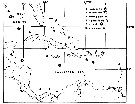 issued from : G.B. Deevey in Proc. Biol. Soc. Wash., 1979, 92 (4). [p.729 Fig.3]. Station locations in the Caribbean Sea and Gulf of Mexico for 6 species of Bathypontia (= Temorites). issued from : G.B. Deevey in Proc. Biol. Soc. Wash., 1979, 92 (4). [p.729 Fig.3]. Station locations in the Caribbean Sea and Gulf of Mexico for 6 species of Bathypontia (= Temorites). |
| | | | Loc: | | | South Africa, Cape Verde Is., Azores, Caribbean, G. of Mexico, off N Cuba, Florida, W Indian, Philippines, off Taiwan | | | | N: | 13 | | | | Lg.: | | | (1) F: 2,6; (8) F: 3,04; M: 3,04-2,74; (317) F: 2,9; M: 2,8; {F: 2,60-3,04; M: 2,74-3,04} | | | | Rem.: | méso-bathypélagique.
Localisations dans le Pacifique à confirmer. | | | Dernière mise à jour : 01/02/2015 | |
|
|
 Toute utilisation de ce site pour une publication sera mentionnée avec la référence suivante : Toute utilisation de ce site pour une publication sera mentionnée avec la référence suivante :
Razouls C., Desreumaux N., Kouwenberg J. et de Bovée F., 2005-2025. - Biodiversité des Copépodes planctoniques marins (morphologie, répartition géographique et données biologiques). Sorbonne Université, CNRS. Disponible sur http://copepodes.obs-banyuls.fr [Accédé le 23 octobre 2025] © copyright 2005-2025 Sorbonne Université, CNRS
|
|
 |
 |









